Motivation and Loyalty Schemes to Attract Customers: Research Proposal
VerifiedAdded on 2020/10/22
|13
|3830
|269
Report
AI Summary
This research proposal investigates the impact of motivation and loyalty schemes on customer attraction and retention, with a focus on the Marks and Spencer (M&S) case study. The study aims to analyze the motivations and expectations behind loyalty schemes, assess their impact on market share, and understand customer decision-making processes regarding different loyalty programs. The research employs an interpretivism philosophy and qualitative approach, collecting primary data through randomly sampled participants to explore questions such as the role of motivation, expectations, and efficient loyalty scheme design. The report includes a literature review examining the themes of motivation, market share sustainability, customer decision-making, and recommendations for efficient customer retention strategies. The methodology section outlines the research philosophy, type, design, sampling, data collection, and ethical considerations. Ultimately, this research seeks to provide valuable insights into the effectiveness of loyalty programs in the modern market and offer actionable recommendations for businesses aiming to enhance customer loyalty and market share.
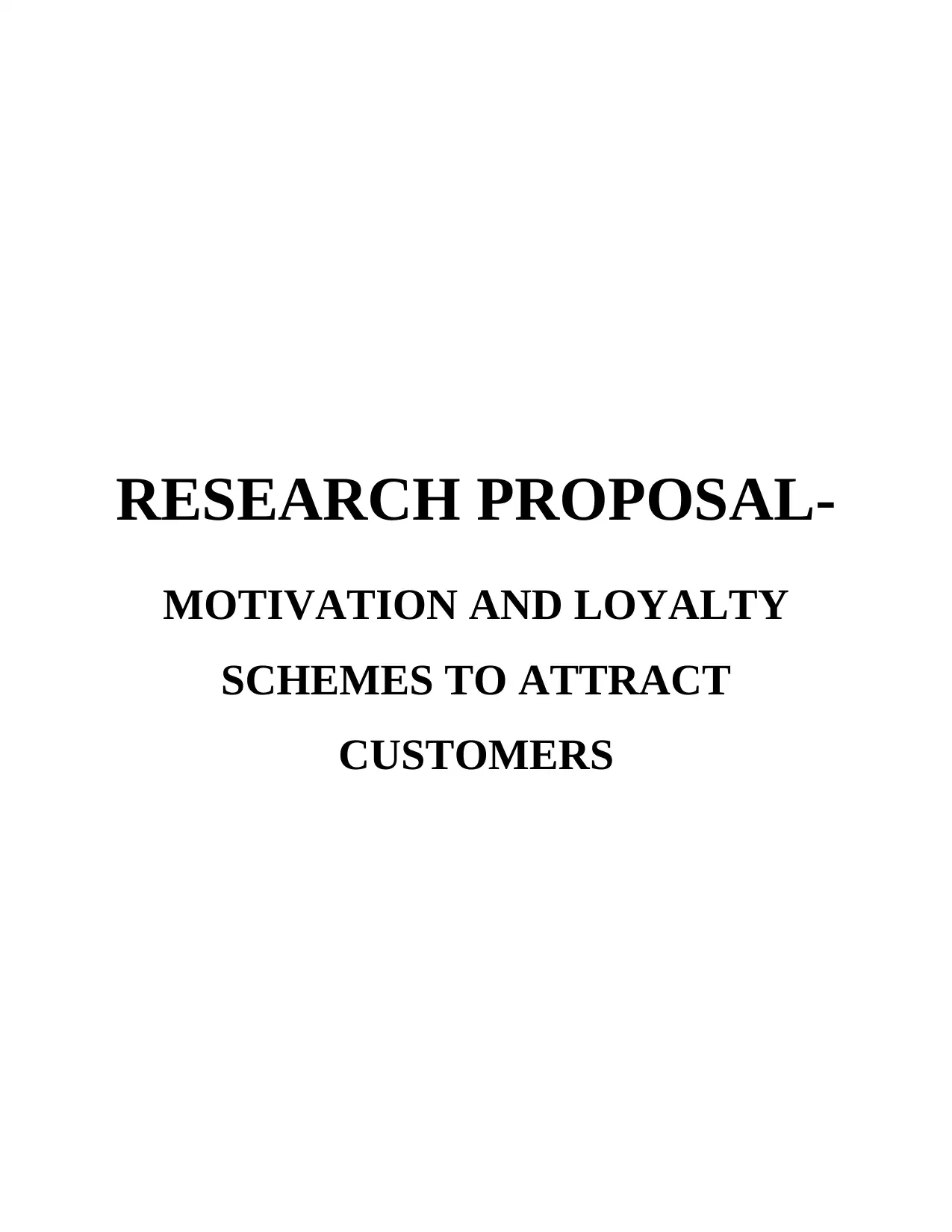
RESEARCH PROPOSAL-
MOTIVATION AND LOYALTY
SCHEMES TO ATTRACT
CUSTOMERS
MOTIVATION AND LOYALTY
SCHEMES TO ATTRACT
CUSTOMERS
Paraphrase This Document
Need a fresh take? Get an instant paraphrase of this document with our AI Paraphraser
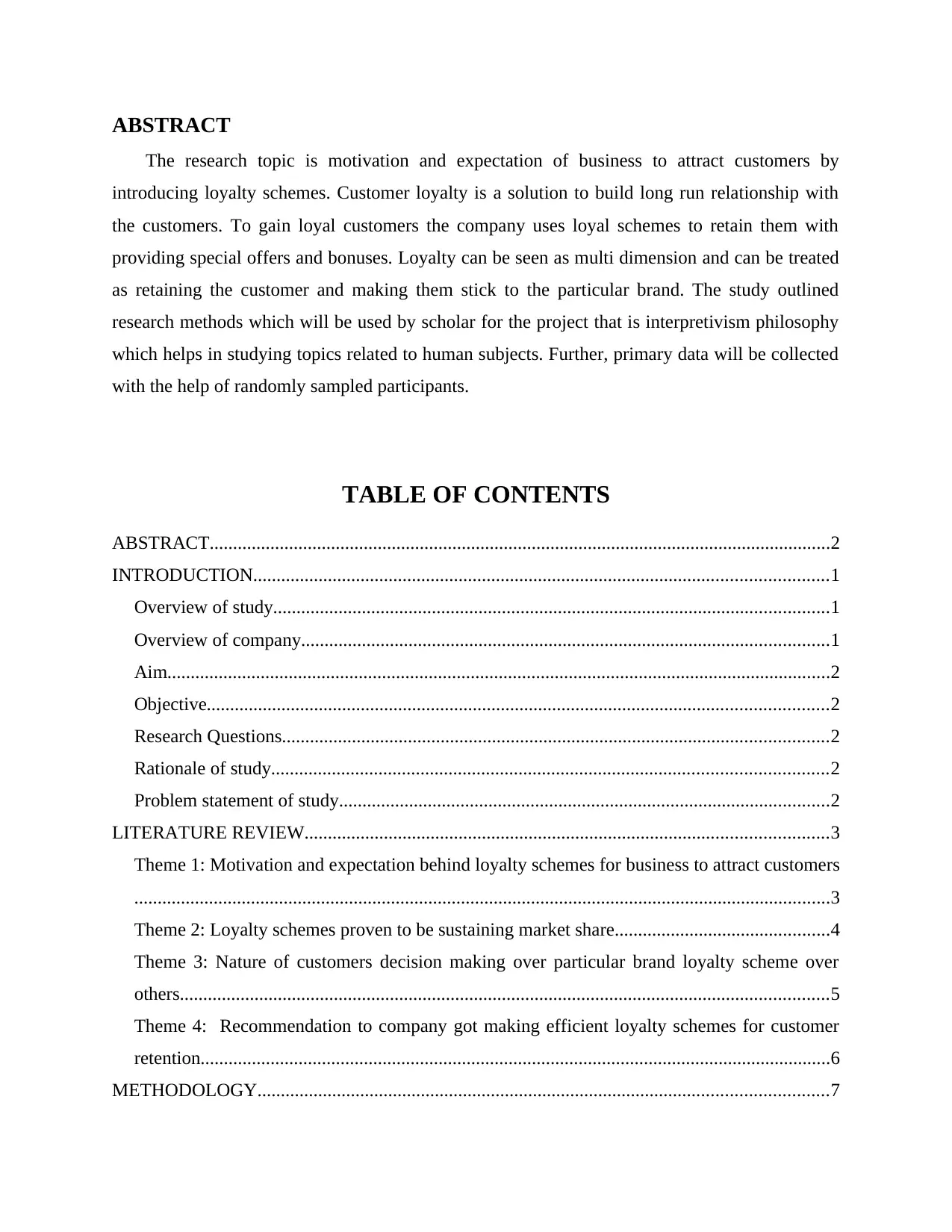
ABSTRACT
The research topic is motivation and expectation of business to attract customers by
introducing loyalty schemes. Customer loyalty is a solution to build long run relationship with
the customers. To gain loyal customers the company uses loyal schemes to retain them with
providing special offers and bonuses. Loyalty can be seen as multi dimension and can be treated
as retaining the customer and making them stick to the particular brand. The study outlined
research methods which will be used by scholar for the project that is interpretivism philosophy
which helps in studying topics related to human subjects. Further, primary data will be collected
with the help of randomly sampled participants.
TABLE OF CONTENTS
ABSTRACT.....................................................................................................................................2
INTRODUCTION...........................................................................................................................1
Overview of study.......................................................................................................................1
Overview of company.................................................................................................................1
Aim..............................................................................................................................................2
Objective.....................................................................................................................................2
Research Questions.....................................................................................................................2
Rationale of study.......................................................................................................................2
Problem statement of study.........................................................................................................2
LITERATURE REVIEW................................................................................................................3
Theme 1: Motivation and expectation behind loyalty schemes for business to attract customers
.....................................................................................................................................................3
Theme 2: Loyalty schemes proven to be sustaining market share..............................................4
Theme 3: Nature of customers decision making over particular brand loyalty scheme over
others...........................................................................................................................................5
Theme 4: Recommendation to company got making efficient loyalty schemes for customer
retention.......................................................................................................................................6
METHODOLOGY..........................................................................................................................7
The research topic is motivation and expectation of business to attract customers by
introducing loyalty schemes. Customer loyalty is a solution to build long run relationship with
the customers. To gain loyal customers the company uses loyal schemes to retain them with
providing special offers and bonuses. Loyalty can be seen as multi dimension and can be treated
as retaining the customer and making them stick to the particular brand. The study outlined
research methods which will be used by scholar for the project that is interpretivism philosophy
which helps in studying topics related to human subjects. Further, primary data will be collected
with the help of randomly sampled participants.
TABLE OF CONTENTS
ABSTRACT.....................................................................................................................................2
INTRODUCTION...........................................................................................................................1
Overview of study.......................................................................................................................1
Overview of company.................................................................................................................1
Aim..............................................................................................................................................2
Objective.....................................................................................................................................2
Research Questions.....................................................................................................................2
Rationale of study.......................................................................................................................2
Problem statement of study.........................................................................................................2
LITERATURE REVIEW................................................................................................................3
Theme 1: Motivation and expectation behind loyalty schemes for business to attract customers
.....................................................................................................................................................3
Theme 2: Loyalty schemes proven to be sustaining market share..............................................4
Theme 3: Nature of customers decision making over particular brand loyalty scheme over
others...........................................................................................................................................5
Theme 4: Recommendation to company got making efficient loyalty schemes for customer
retention.......................................................................................................................................6
METHODOLOGY..........................................................................................................................7
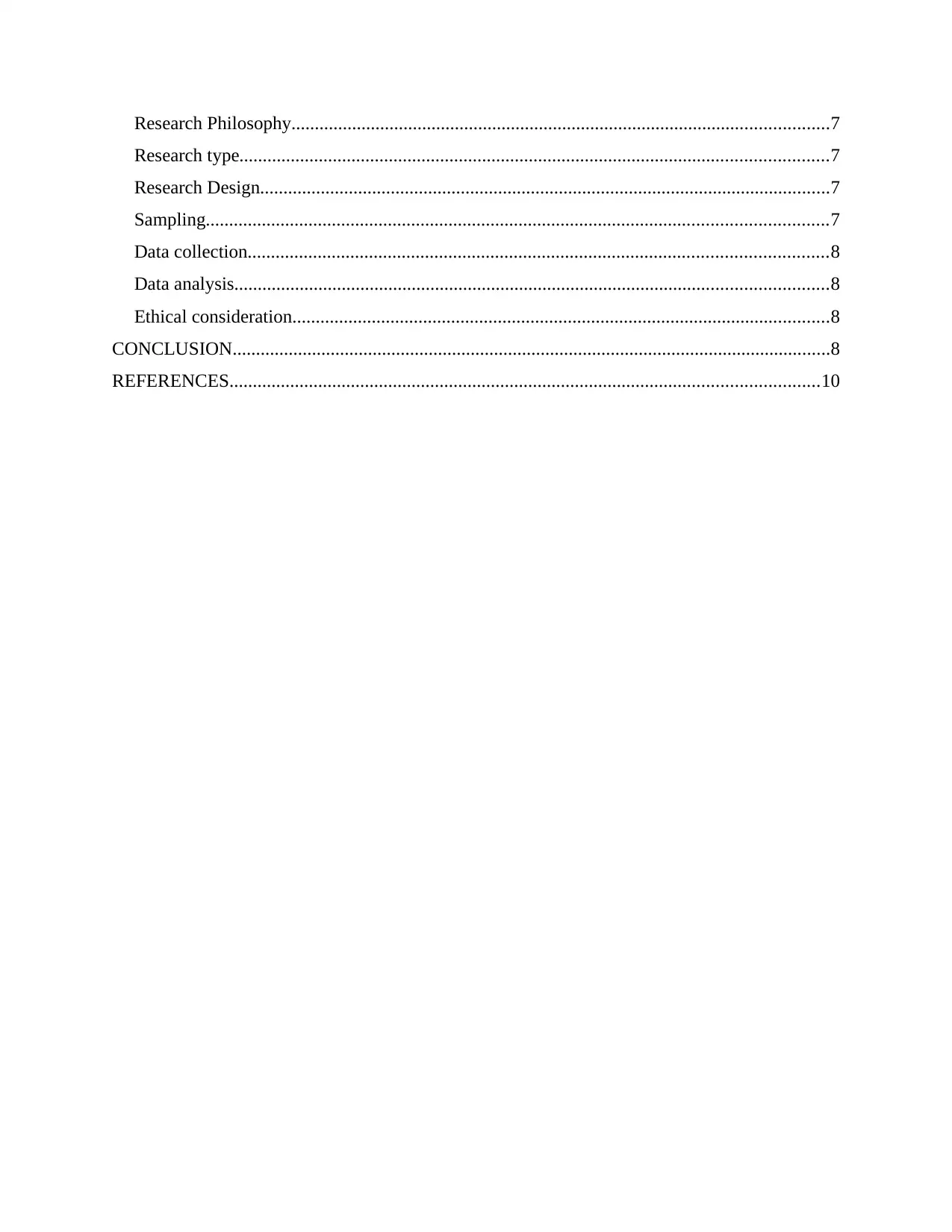
Research Philosophy...................................................................................................................7
Research type..............................................................................................................................7
Research Design..........................................................................................................................7
Sampling.....................................................................................................................................7
Data collection............................................................................................................................8
Data analysis...............................................................................................................................8
Ethical consideration...................................................................................................................8
CONCLUSION................................................................................................................................8
REFERENCES..............................................................................................................................10
Research type..............................................................................................................................7
Research Design..........................................................................................................................7
Sampling.....................................................................................................................................7
Data collection............................................................................................................................8
Data analysis...............................................................................................................................8
Ethical consideration...................................................................................................................8
CONCLUSION................................................................................................................................8
REFERENCES..............................................................................................................................10
⊘ This is a preview!⊘
Do you want full access?
Subscribe today to unlock all pages.

Trusted by 1+ million students worldwide
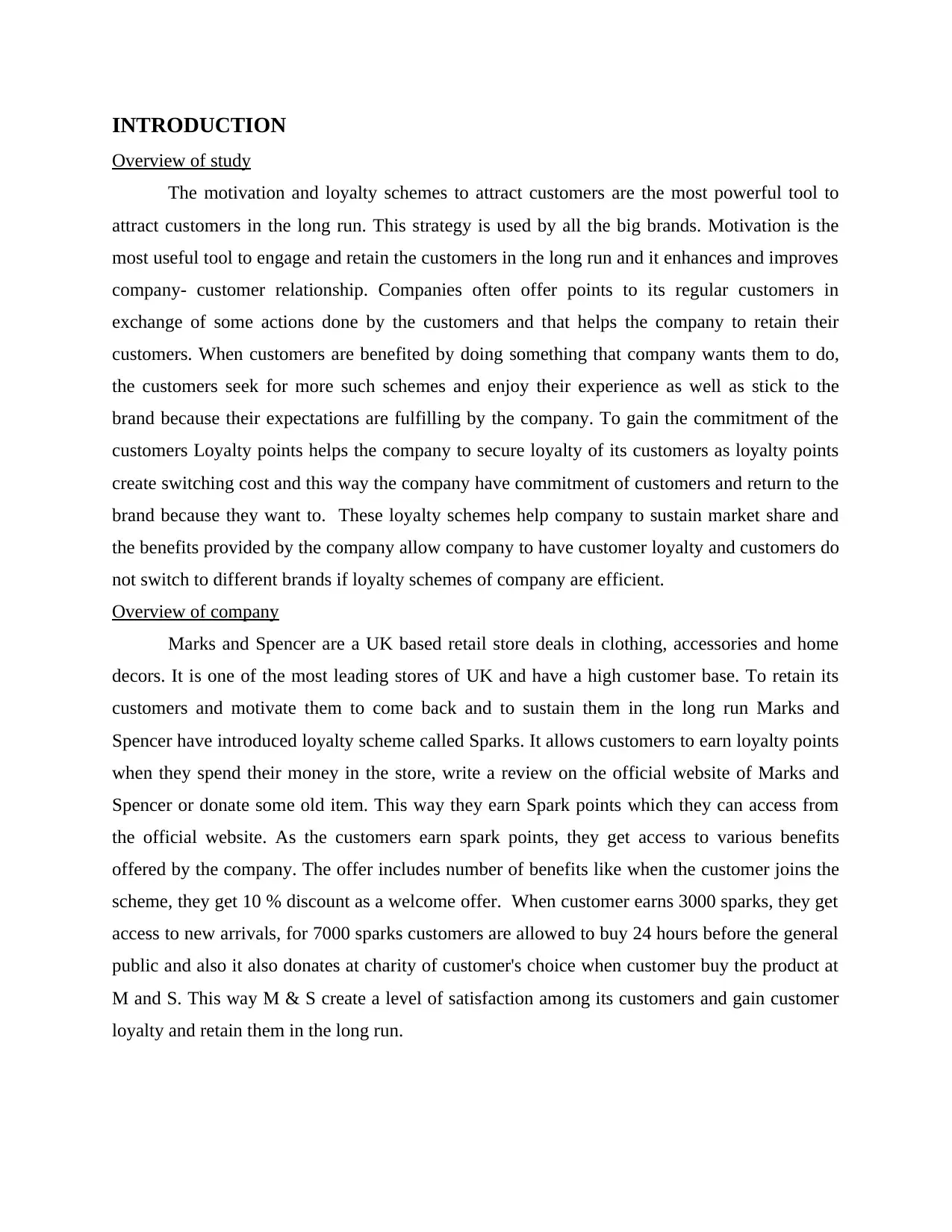
INTRODUCTION
Overview of study
The motivation and loyalty schemes to attract customers are the most powerful tool to
attract customers in the long run. This strategy is used by all the big brands. Motivation is the
most useful tool to engage and retain the customers in the long run and it enhances and improves
company- customer relationship. Companies often offer points to its regular customers in
exchange of some actions done by the customers and that helps the company to retain their
customers. When customers are benefited by doing something that company wants them to do,
the customers seek for more such schemes and enjoy their experience as well as stick to the
brand because their expectations are fulfilling by the company. To gain the commitment of the
customers Loyalty points helps the company to secure loyalty of its customers as loyalty points
create switching cost and this way the company have commitment of customers and return to the
brand because they want to. These loyalty schemes help company to sustain market share and
the benefits provided by the company allow company to have customer loyalty and customers do
not switch to different brands if loyalty schemes of company are efficient.
Overview of company
Marks and Spencer are a UK based retail store deals in clothing, accessories and home
decors. It is one of the most leading stores of UK and have a high customer base. To retain its
customers and motivate them to come back and to sustain them in the long run Marks and
Spencer have introduced loyalty scheme called Sparks. It allows customers to earn loyalty points
when they spend their money in the store, write a review on the official website of Marks and
Spencer or donate some old item. This way they earn Spark points which they can access from
the official website. As the customers earn spark points, they get access to various benefits
offered by the company. The offer includes number of benefits like when the customer joins the
scheme, they get 10 % discount as a welcome offer. When customer earns 3000 sparks, they get
access to new arrivals, for 7000 sparks customers are allowed to buy 24 hours before the general
public and also it also donates at charity of customer's choice when customer buy the product at
M and S. This way M & S create a level of satisfaction among its customers and gain customer
loyalty and retain them in the long run.
Overview of study
The motivation and loyalty schemes to attract customers are the most powerful tool to
attract customers in the long run. This strategy is used by all the big brands. Motivation is the
most useful tool to engage and retain the customers in the long run and it enhances and improves
company- customer relationship. Companies often offer points to its regular customers in
exchange of some actions done by the customers and that helps the company to retain their
customers. When customers are benefited by doing something that company wants them to do,
the customers seek for more such schemes and enjoy their experience as well as stick to the
brand because their expectations are fulfilling by the company. To gain the commitment of the
customers Loyalty points helps the company to secure loyalty of its customers as loyalty points
create switching cost and this way the company have commitment of customers and return to the
brand because they want to. These loyalty schemes help company to sustain market share and
the benefits provided by the company allow company to have customer loyalty and customers do
not switch to different brands if loyalty schemes of company are efficient.
Overview of company
Marks and Spencer are a UK based retail store deals in clothing, accessories and home
decors. It is one of the most leading stores of UK and have a high customer base. To retain its
customers and motivate them to come back and to sustain them in the long run Marks and
Spencer have introduced loyalty scheme called Sparks. It allows customers to earn loyalty points
when they spend their money in the store, write a review on the official website of Marks and
Spencer or donate some old item. This way they earn Spark points which they can access from
the official website. As the customers earn spark points, they get access to various benefits
offered by the company. The offer includes number of benefits like when the customer joins the
scheme, they get 10 % discount as a welcome offer. When customer earns 3000 sparks, they get
access to new arrivals, for 7000 sparks customers are allowed to buy 24 hours before the general
public and also it also donates at charity of customer's choice when customer buy the product at
M and S. This way M & S create a level of satisfaction among its customers and gain customer
loyalty and retain them in the long run.
Paraphrase This Document
Need a fresh take? Get an instant paraphrase of this document with our AI Paraphraser
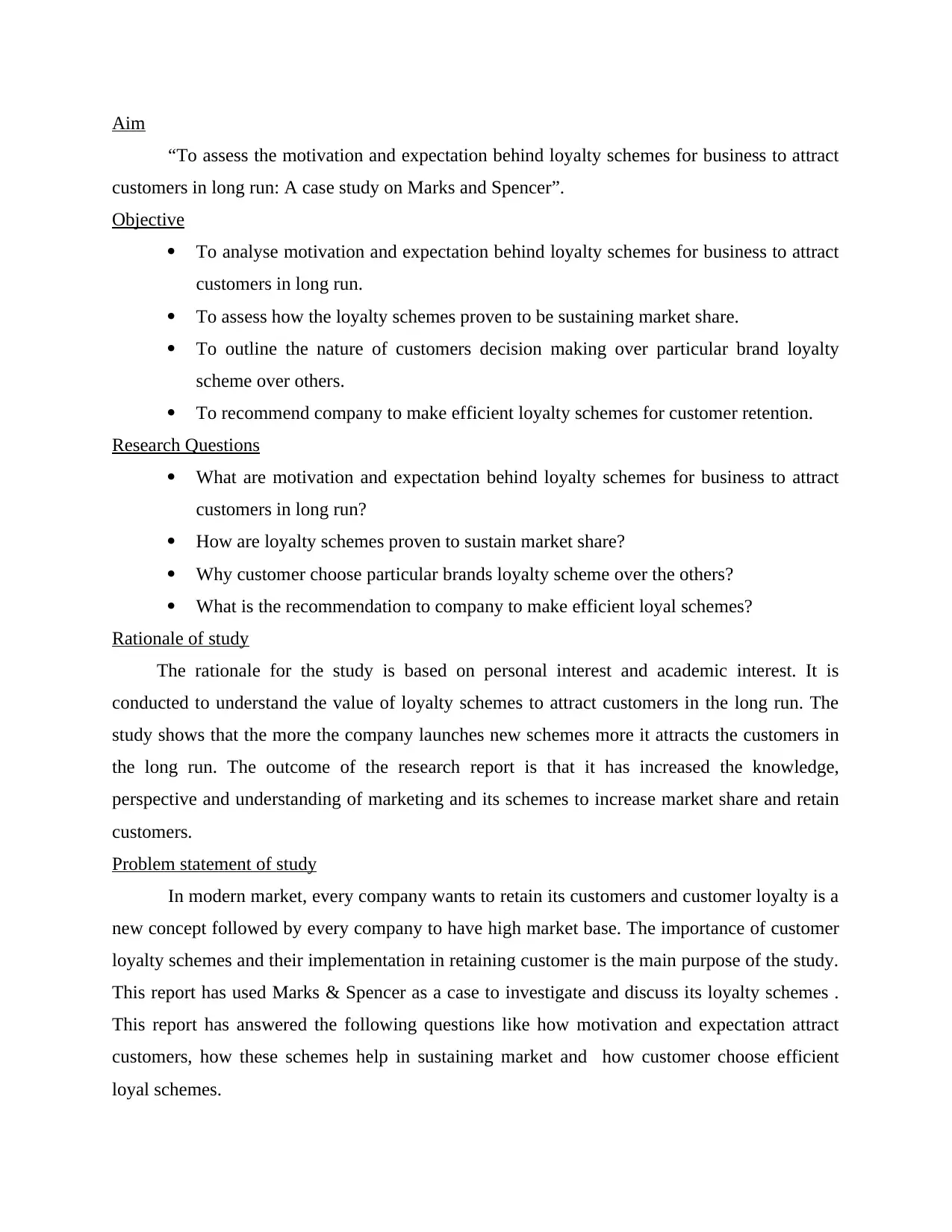
Aim
“To assess the motivation and expectation behind loyalty schemes for business to attract
customers in long run: A case study on Marks and Spencer”.
Objective
To analyse motivation and expectation behind loyalty schemes for business to attract
customers in long run.
To assess how the loyalty schemes proven to be sustaining market share.
To outline the nature of customers decision making over particular brand loyalty
scheme over others.
To recommend company to make efficient loyalty schemes for customer retention.
Research Questions
What are motivation and expectation behind loyalty schemes for business to attract
customers in long run?
How are loyalty schemes proven to sustain market share?
Why customer choose particular brands loyalty scheme over the others?
What is the recommendation to company to make efficient loyal schemes?
Rationale of study
The rationale for the study is based on personal interest and academic interest. It is
conducted to understand the value of loyalty schemes to attract customers in the long run. The
study shows that the more the company launches new schemes more it attracts the customers in
the long run. The outcome of the research report is that it has increased the knowledge,
perspective and understanding of marketing and its schemes to increase market share and retain
customers.
Problem statement of study
In modern market, every company wants to retain its customers and customer loyalty is a
new concept followed by every company to have high market base. The importance of customer
loyalty schemes and their implementation in retaining customer is the main purpose of the study.
This report has used Marks & Spencer as a case to investigate and discuss its loyalty schemes .
This report has answered the following questions like how motivation and expectation attract
customers, how these schemes help in sustaining market and how customer choose efficient
loyal schemes.
“To assess the motivation and expectation behind loyalty schemes for business to attract
customers in long run: A case study on Marks and Spencer”.
Objective
To analyse motivation and expectation behind loyalty schemes for business to attract
customers in long run.
To assess how the loyalty schemes proven to be sustaining market share.
To outline the nature of customers decision making over particular brand loyalty
scheme over others.
To recommend company to make efficient loyalty schemes for customer retention.
Research Questions
What are motivation and expectation behind loyalty schemes for business to attract
customers in long run?
How are loyalty schemes proven to sustain market share?
Why customer choose particular brands loyalty scheme over the others?
What is the recommendation to company to make efficient loyal schemes?
Rationale of study
The rationale for the study is based on personal interest and academic interest. It is
conducted to understand the value of loyalty schemes to attract customers in the long run. The
study shows that the more the company launches new schemes more it attracts the customers in
the long run. The outcome of the research report is that it has increased the knowledge,
perspective and understanding of marketing and its schemes to increase market share and retain
customers.
Problem statement of study
In modern market, every company wants to retain its customers and customer loyalty is a
new concept followed by every company to have high market base. The importance of customer
loyalty schemes and their implementation in retaining customer is the main purpose of the study.
This report has used Marks & Spencer as a case to investigate and discuss its loyalty schemes .
This report has answered the following questions like how motivation and expectation attract
customers, how these schemes help in sustaining market and how customer choose efficient
loyal schemes.
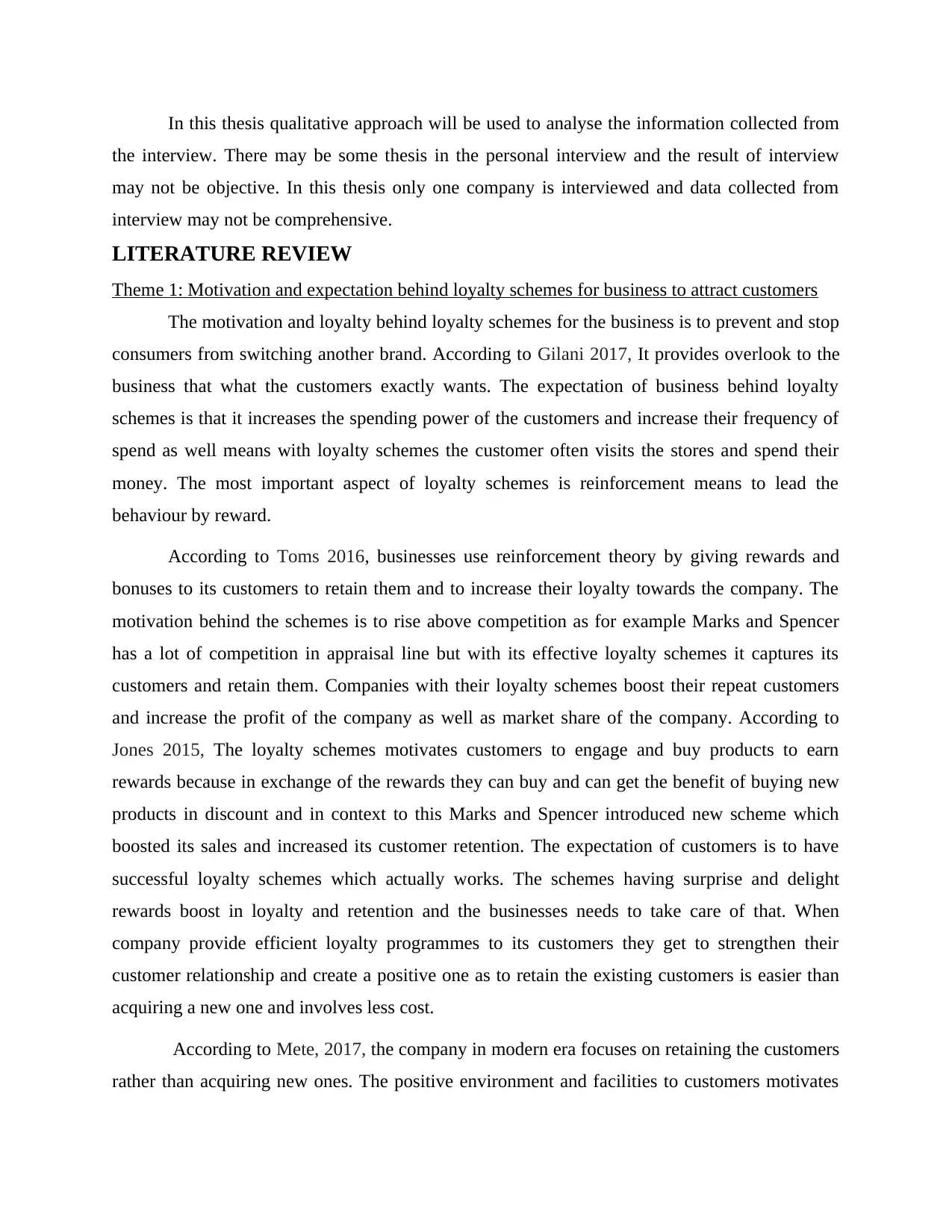
In this thesis qualitative approach will be used to analyse the information collected from
the interview. There may be some thesis in the personal interview and the result of interview
may not be objective. In this thesis only one company is interviewed and data collected from
interview may not be comprehensive.
LITERATURE REVIEW
Theme 1: Motivation and expectation behind loyalty schemes for business to attract customers
The motivation and loyalty behind loyalty schemes for the business is to prevent and stop
consumers from switching another brand. According to Gilani 2017, It provides overlook to the
business that what the customers exactly wants. The expectation of business behind loyalty
schemes is that it increases the spending power of the customers and increase their frequency of
spend as well means with loyalty schemes the customer often visits the stores and spend their
money. The most important aspect of loyalty schemes is reinforcement means to lead the
behaviour by reward.
According to Toms 2016, businesses use reinforcement theory by giving rewards and
bonuses to its customers to retain them and to increase their loyalty towards the company. The
motivation behind the schemes is to rise above competition as for example Marks and Spencer
has a lot of competition in appraisal line but with its effective loyalty schemes it captures its
customers and retain them. Companies with their loyalty schemes boost their repeat customers
and increase the profit of the company as well as market share of the company. According to
Jones 2015, The loyalty schemes motivates customers to engage and buy products to earn
rewards because in exchange of the rewards they can buy and can get the benefit of buying new
products in discount and in context to this Marks and Spencer introduced new scheme which
boosted its sales and increased its customer retention. The expectation of customers is to have
successful loyalty schemes which actually works. The schemes having surprise and delight
rewards boost in loyalty and retention and the businesses needs to take care of that. When
company provide efficient loyalty programmes to its customers they get to strengthen their
customer relationship and create a positive one as to retain the existing customers is easier than
acquiring a new one and involves less cost.
According to Mete, 2017, the company in modern era focuses on retaining the customers
rather than acquiring new ones. The positive environment and facilities to customers motivates
the interview. There may be some thesis in the personal interview and the result of interview
may not be objective. In this thesis only one company is interviewed and data collected from
interview may not be comprehensive.
LITERATURE REVIEW
Theme 1: Motivation and expectation behind loyalty schemes for business to attract customers
The motivation and loyalty behind loyalty schemes for the business is to prevent and stop
consumers from switching another brand. According to Gilani 2017, It provides overlook to the
business that what the customers exactly wants. The expectation of business behind loyalty
schemes is that it increases the spending power of the customers and increase their frequency of
spend as well means with loyalty schemes the customer often visits the stores and spend their
money. The most important aspect of loyalty schemes is reinforcement means to lead the
behaviour by reward.
According to Toms 2016, businesses use reinforcement theory by giving rewards and
bonuses to its customers to retain them and to increase their loyalty towards the company. The
motivation behind the schemes is to rise above competition as for example Marks and Spencer
has a lot of competition in appraisal line but with its effective loyalty schemes it captures its
customers and retain them. Companies with their loyalty schemes boost their repeat customers
and increase the profit of the company as well as market share of the company. According to
Jones 2015, The loyalty schemes motivates customers to engage and buy products to earn
rewards because in exchange of the rewards they can buy and can get the benefit of buying new
products in discount and in context to this Marks and Spencer introduced new scheme which
boosted its sales and increased its customer retention. The expectation of customers is to have
successful loyalty schemes which actually works. The schemes having surprise and delight
rewards boost in loyalty and retention and the businesses needs to take care of that. When
company provide efficient loyalty programmes to its customers they get to strengthen their
customer relationship and create a positive one as to retain the existing customers is easier than
acquiring a new one and involves less cost.
According to Mete, 2017, the company in modern era focuses on retaining the customers
rather than acquiring new ones. The positive environment and facilities to customers motivates
⊘ This is a preview!⊘
Do you want full access?
Subscribe today to unlock all pages.

Trusted by 1+ million students worldwide
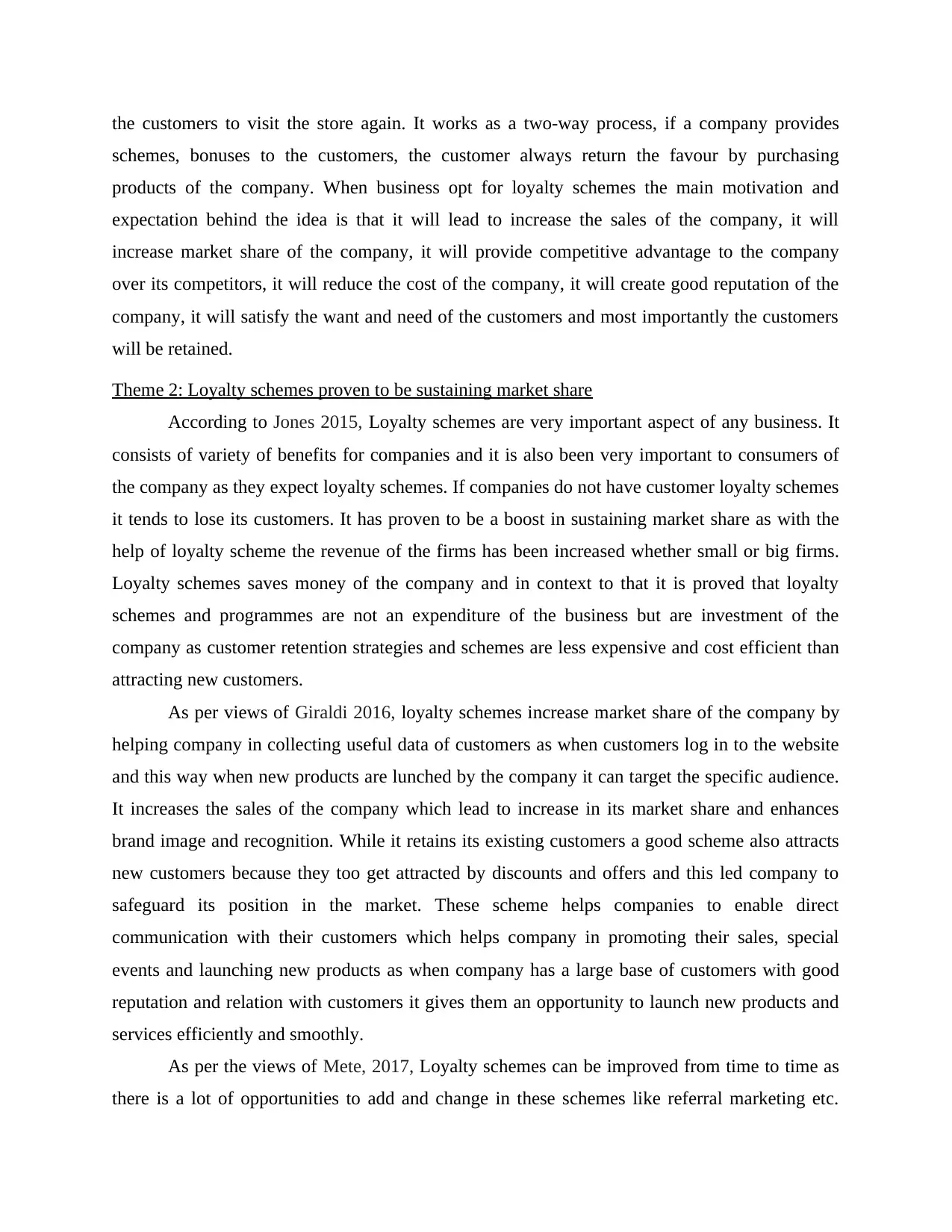
the customers to visit the store again. It works as a two-way process, if a company provides
schemes, bonuses to the customers, the customer always return the favour by purchasing
products of the company. When business opt for loyalty schemes the main motivation and
expectation behind the idea is that it will lead to increase the sales of the company, it will
increase market share of the company, it will provide competitive advantage to the company
over its competitors, it will reduce the cost of the company, it will create good reputation of the
company, it will satisfy the want and need of the customers and most importantly the customers
will be retained.
Theme 2: Loyalty schemes proven to be sustaining market share
According to Jones 2015, Loyalty schemes are very important aspect of any business. It
consists of variety of benefits for companies and it is also been very important to consumers of
the company as they expect loyalty schemes. If companies do not have customer loyalty schemes
it tends to lose its customers. It has proven to be a boost in sustaining market share as with the
help of loyalty scheme the revenue of the firms has been increased whether small or big firms.
Loyalty schemes saves money of the company and in context to that it is proved that loyalty
schemes and programmes are not an expenditure of the business but are investment of the
company as customer retention strategies and schemes are less expensive and cost efficient than
attracting new customers.
As per views of Giraldi 2016, loyalty schemes increase market share of the company by
helping company in collecting useful data of customers as when customers log in to the website
and this way when new products are lunched by the company it can target the specific audience.
It increases the sales of the company which lead to increase in its market share and enhances
brand image and recognition. While it retains its existing customers a good scheme also attracts
new customers because they too get attracted by discounts and offers and this led company to
safeguard its position in the market. These scheme helps companies to enable direct
communication with their customers which helps company in promoting their sales, special
events and launching new products as when company has a large base of customers with good
reputation and relation with customers it gives them an opportunity to launch new products and
services efficiently and smoothly.
As per the views of Mete, 2017, Loyalty schemes can be improved from time to time as
there is a lot of opportunities to add and change in these schemes like referral marketing etc.
schemes, bonuses to the customers, the customer always return the favour by purchasing
products of the company. When business opt for loyalty schemes the main motivation and
expectation behind the idea is that it will lead to increase the sales of the company, it will
increase market share of the company, it will provide competitive advantage to the company
over its competitors, it will reduce the cost of the company, it will create good reputation of the
company, it will satisfy the want and need of the customers and most importantly the customers
will be retained.
Theme 2: Loyalty schemes proven to be sustaining market share
According to Jones 2015, Loyalty schemes are very important aspect of any business. It
consists of variety of benefits for companies and it is also been very important to consumers of
the company as they expect loyalty schemes. If companies do not have customer loyalty schemes
it tends to lose its customers. It has proven to be a boost in sustaining market share as with the
help of loyalty scheme the revenue of the firms has been increased whether small or big firms.
Loyalty schemes saves money of the company and in context to that it is proved that loyalty
schemes and programmes are not an expenditure of the business but are investment of the
company as customer retention strategies and schemes are less expensive and cost efficient than
attracting new customers.
As per views of Giraldi 2016, loyalty schemes increase market share of the company by
helping company in collecting useful data of customers as when customers log in to the website
and this way when new products are lunched by the company it can target the specific audience.
It increases the sales of the company which lead to increase in its market share and enhances
brand image and recognition. While it retains its existing customers a good scheme also attracts
new customers because they too get attracted by discounts and offers and this led company to
safeguard its position in the market. These scheme helps companies to enable direct
communication with their customers which helps company in promoting their sales, special
events and launching new products as when company has a large base of customers with good
reputation and relation with customers it gives them an opportunity to launch new products and
services efficiently and smoothly.
As per the views of Mete, 2017, Loyalty schemes can be improved from time to time as
there is a lot of opportunities to add and change in these schemes like referral marketing etc.
Paraphrase This Document
Need a fresh take? Get an instant paraphrase of this document with our AI Paraphraser
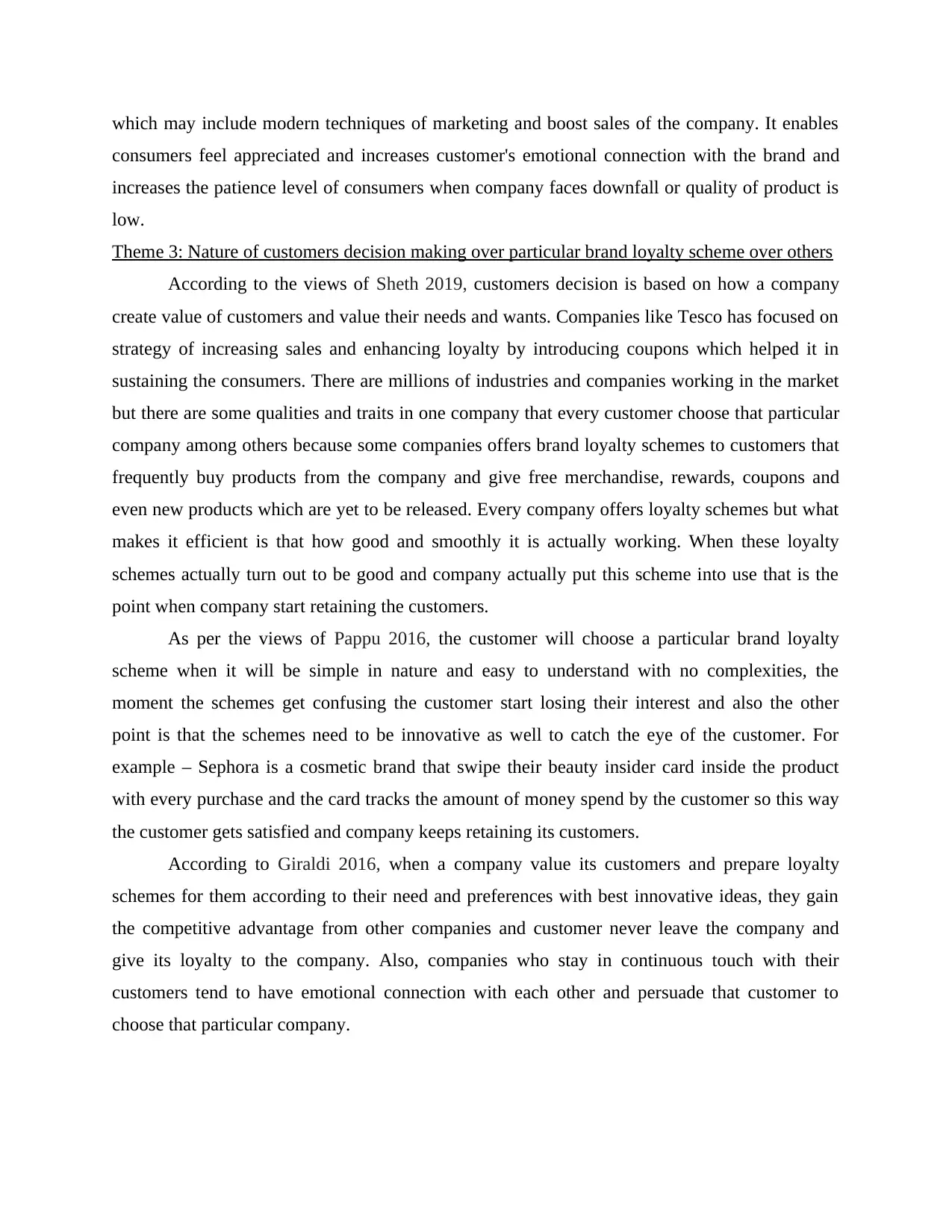
which may include modern techniques of marketing and boost sales of the company. It enables
consumers feel appreciated and increases customer's emotional connection with the brand and
increases the patience level of consumers when company faces downfall or quality of product is
low.
Theme 3: Nature of customers decision making over particular brand loyalty scheme over others
According to the views of Sheth 2019, customers decision is based on how a company
create value of customers and value their needs and wants. Companies like Tesco has focused on
strategy of increasing sales and enhancing loyalty by introducing coupons which helped it in
sustaining the consumers. There are millions of industries and companies working in the market
but there are some qualities and traits in one company that every customer choose that particular
company among others because some companies offers brand loyalty schemes to customers that
frequently buy products from the company and give free merchandise, rewards, coupons and
even new products which are yet to be released. Every company offers loyalty schemes but what
makes it efficient is that how good and smoothly it is actually working. When these loyalty
schemes actually turn out to be good and company actually put this scheme into use that is the
point when company start retaining the customers.
As per the views of Pappu 2016, the customer will choose a particular brand loyalty
scheme when it will be simple in nature and easy to understand with no complexities, the
moment the schemes get confusing the customer start losing their interest and also the other
point is that the schemes need to be innovative as well to catch the eye of the customer. For
example – Sephora is a cosmetic brand that swipe their beauty insider card inside the product
with every purchase and the card tracks the amount of money spend by the customer so this way
the customer gets satisfied and company keeps retaining its customers.
According to Giraldi 2016, when a company value its customers and prepare loyalty
schemes for them according to their need and preferences with best innovative ideas, they gain
the competitive advantage from other companies and customer never leave the company and
give its loyalty to the company. Also, companies who stay in continuous touch with their
customers tend to have emotional connection with each other and persuade that customer to
choose that particular company.
consumers feel appreciated and increases customer's emotional connection with the brand and
increases the patience level of consumers when company faces downfall or quality of product is
low.
Theme 3: Nature of customers decision making over particular brand loyalty scheme over others
According to the views of Sheth 2019, customers decision is based on how a company
create value of customers and value their needs and wants. Companies like Tesco has focused on
strategy of increasing sales and enhancing loyalty by introducing coupons which helped it in
sustaining the consumers. There are millions of industries and companies working in the market
but there are some qualities and traits in one company that every customer choose that particular
company among others because some companies offers brand loyalty schemes to customers that
frequently buy products from the company and give free merchandise, rewards, coupons and
even new products which are yet to be released. Every company offers loyalty schemes but what
makes it efficient is that how good and smoothly it is actually working. When these loyalty
schemes actually turn out to be good and company actually put this scheme into use that is the
point when company start retaining the customers.
As per the views of Pappu 2016, the customer will choose a particular brand loyalty
scheme when it will be simple in nature and easy to understand with no complexities, the
moment the schemes get confusing the customer start losing their interest and also the other
point is that the schemes need to be innovative as well to catch the eye of the customer. For
example – Sephora is a cosmetic brand that swipe their beauty insider card inside the product
with every purchase and the card tracks the amount of money spend by the customer so this way
the customer gets satisfied and company keeps retaining its customers.
According to Giraldi 2016, when a company value its customers and prepare loyalty
schemes for them according to their need and preferences with best innovative ideas, they gain
the competitive advantage from other companies and customer never leave the company and
give its loyalty to the company. Also, companies who stay in continuous touch with their
customers tend to have emotional connection with each other and persuade that customer to
choose that particular company.
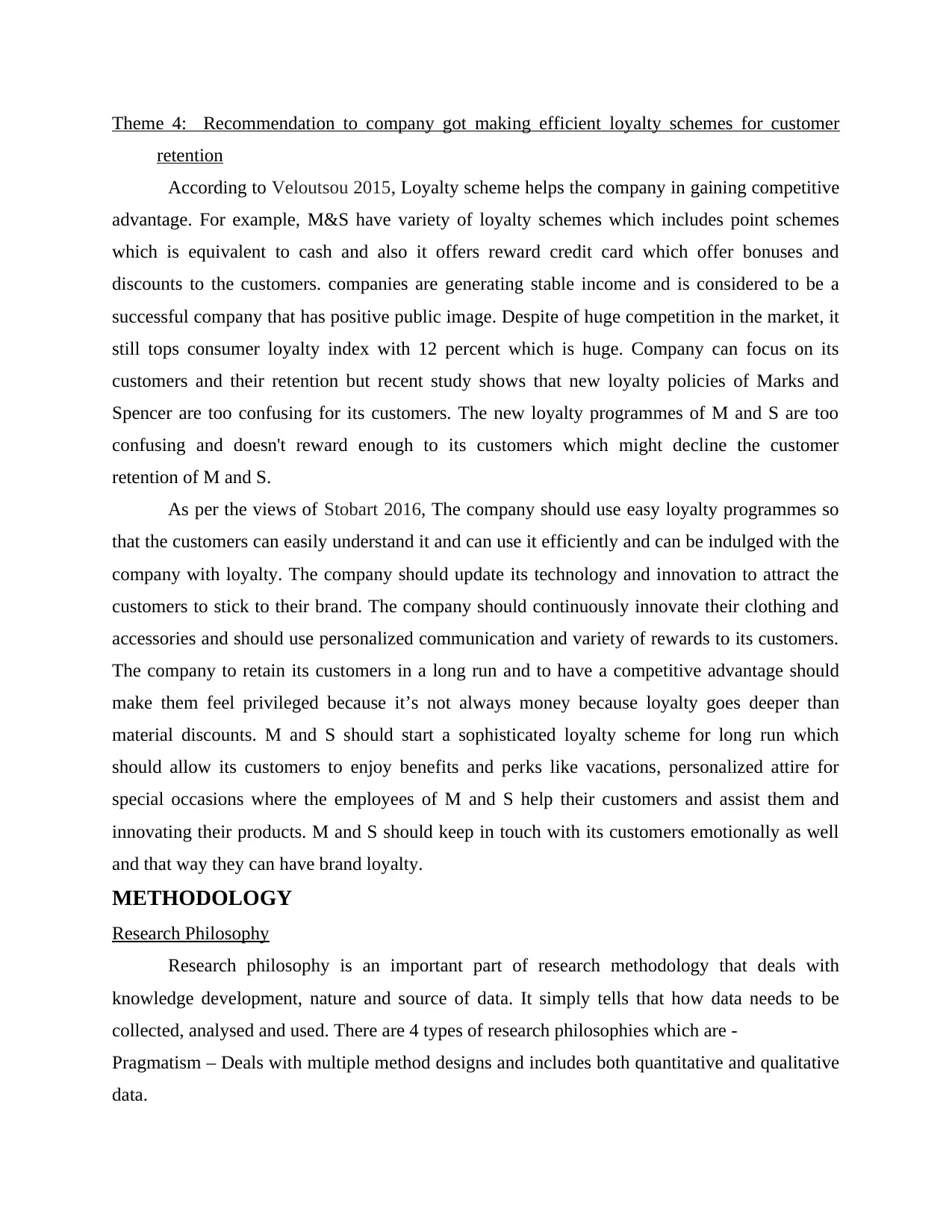
Theme 4: Recommendation to company got making efficient loyalty schemes for customer
retention
According to Veloutsou 2015, Loyalty scheme helps the company in gaining competitive
advantage. For example, M&S have variety of loyalty schemes which includes point schemes
which is equivalent to cash and also it offers reward credit card which offer bonuses and
discounts to the customers. companies are generating stable income and is considered to be a
successful company that has positive public image. Despite of huge competition in the market, it
still tops consumer loyalty index with 12 percent which is huge. Company can focus on its
customers and their retention but recent study shows that new loyalty policies of Marks and
Spencer are too confusing for its customers. The new loyalty programmes of M and S are too
confusing and doesn't reward enough to its customers which might decline the customer
retention of M and S.
As per the views of Stobart 2016, The company should use easy loyalty programmes so
that the customers can easily understand it and can use it efficiently and can be indulged with the
company with loyalty. The company should update its technology and innovation to attract the
customers to stick to their brand. The company should continuously innovate their clothing and
accessories and should use personalized communication and variety of rewards to its customers.
The company to retain its customers in a long run and to have a competitive advantage should
make them feel privileged because it’s not always money because loyalty goes deeper than
material discounts. M and S should start a sophisticated loyalty scheme for long run which
should allow its customers to enjoy benefits and perks like vacations, personalized attire for
special occasions where the employees of M and S help their customers and assist them and
innovating their products. M and S should keep in touch with its customers emotionally as well
and that way they can have brand loyalty.
METHODOLOGY
Research Philosophy
Research philosophy is an important part of research methodology that deals with
knowledge development, nature and source of data. It simply tells that how data needs to be
collected, analysed and used. There are 4 types of research philosophies which are -
Pragmatism – Deals with multiple method designs and includes both quantitative and qualitative
data.
retention
According to Veloutsou 2015, Loyalty scheme helps the company in gaining competitive
advantage. For example, M&S have variety of loyalty schemes which includes point schemes
which is equivalent to cash and also it offers reward credit card which offer bonuses and
discounts to the customers. companies are generating stable income and is considered to be a
successful company that has positive public image. Despite of huge competition in the market, it
still tops consumer loyalty index with 12 percent which is huge. Company can focus on its
customers and their retention but recent study shows that new loyalty policies of Marks and
Spencer are too confusing for its customers. The new loyalty programmes of M and S are too
confusing and doesn't reward enough to its customers which might decline the customer
retention of M and S.
As per the views of Stobart 2016, The company should use easy loyalty programmes so
that the customers can easily understand it and can use it efficiently and can be indulged with the
company with loyalty. The company should update its technology and innovation to attract the
customers to stick to their brand. The company should continuously innovate their clothing and
accessories and should use personalized communication and variety of rewards to its customers.
The company to retain its customers in a long run and to have a competitive advantage should
make them feel privileged because it’s not always money because loyalty goes deeper than
material discounts. M and S should start a sophisticated loyalty scheme for long run which
should allow its customers to enjoy benefits and perks like vacations, personalized attire for
special occasions where the employees of M and S help their customers and assist them and
innovating their products. M and S should keep in touch with its customers emotionally as well
and that way they can have brand loyalty.
METHODOLOGY
Research Philosophy
Research philosophy is an important part of research methodology that deals with
knowledge development, nature and source of data. It simply tells that how data needs to be
collected, analysed and used. There are 4 types of research philosophies which are -
Pragmatism – Deals with multiple method designs and includes both quantitative and qualitative
data.
⊘ This is a preview!⊘
Do you want full access?
Subscribe today to unlock all pages.

Trusted by 1+ million students worldwide
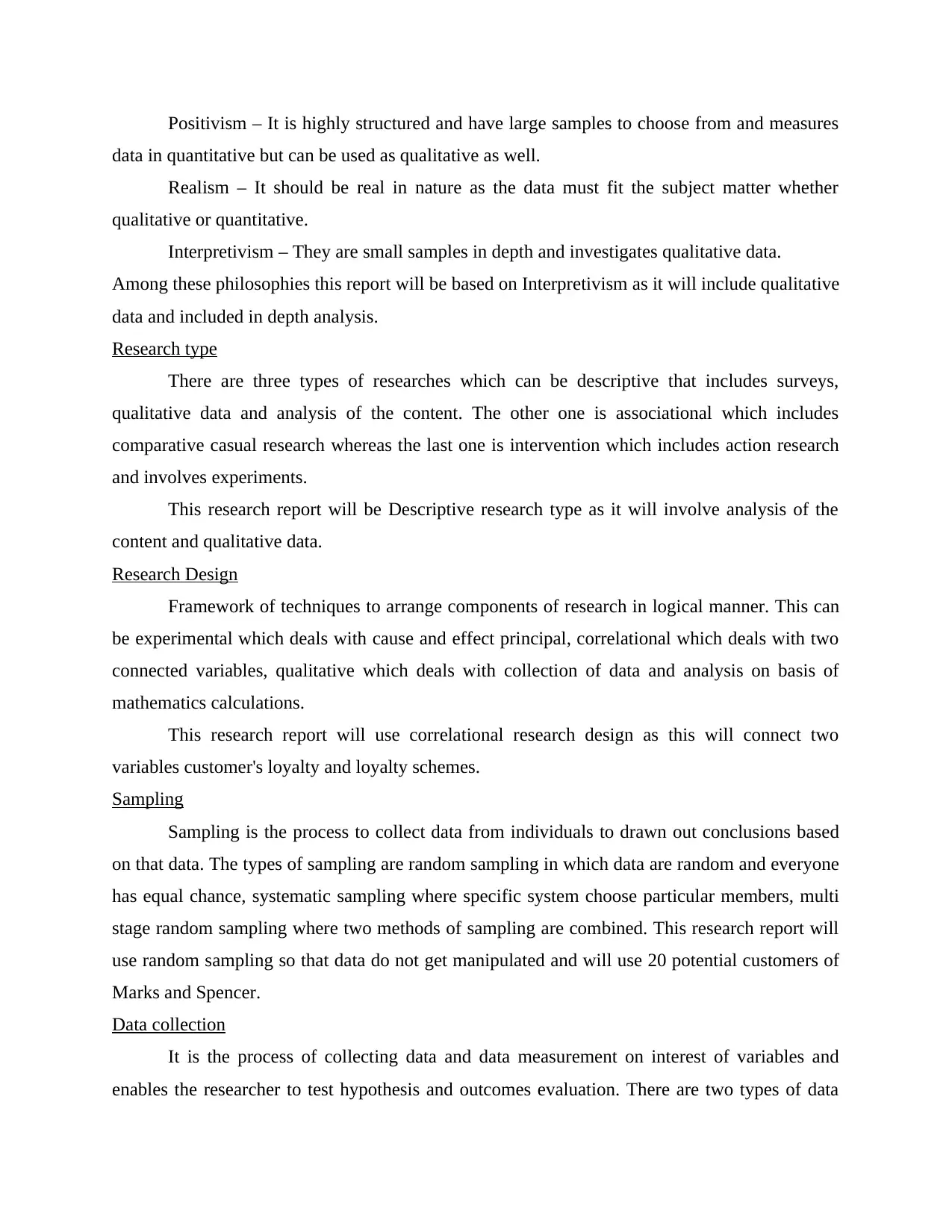
Positivism – It is highly structured and have large samples to choose from and measures
data in quantitative but can be used as qualitative as well.
Realism – It should be real in nature as the data must fit the subject matter whether
qualitative or quantitative.
Interpretivism – They are small samples in depth and investigates qualitative data.
Among these philosophies this report will be based on Interpretivism as it will include qualitative
data and included in depth analysis.
Research type
There are three types of researches which can be descriptive that includes surveys,
qualitative data and analysis of the content. The other one is associational which includes
comparative casual research whereas the last one is intervention which includes action research
and involves experiments.
This research report will be Descriptive research type as it will involve analysis of the
content and qualitative data.
Research Design
Framework of techniques to arrange components of research in logical manner. This can
be experimental which deals with cause and effect principal, correlational which deals with two
connected variables, qualitative which deals with collection of data and analysis on basis of
mathematics calculations.
This research report will use correlational research design as this will connect two
variables customer's loyalty and loyalty schemes.
Sampling
Sampling is the process to collect data from individuals to drawn out conclusions based
on that data. The types of sampling are random sampling in which data are random and everyone
has equal chance, systematic sampling where specific system choose particular members, multi
stage random sampling where two methods of sampling are combined. This research report will
use random sampling so that data do not get manipulated and will use 20 potential customers of
Marks and Spencer.
Data collection
It is the process of collecting data and data measurement on interest of variables and
enables the researcher to test hypothesis and outcomes evaluation. There are two types of data
data in quantitative but can be used as qualitative as well.
Realism – It should be real in nature as the data must fit the subject matter whether
qualitative or quantitative.
Interpretivism – They are small samples in depth and investigates qualitative data.
Among these philosophies this report will be based on Interpretivism as it will include qualitative
data and included in depth analysis.
Research type
There are three types of researches which can be descriptive that includes surveys,
qualitative data and analysis of the content. The other one is associational which includes
comparative casual research whereas the last one is intervention which includes action research
and involves experiments.
This research report will be Descriptive research type as it will involve analysis of the
content and qualitative data.
Research Design
Framework of techniques to arrange components of research in logical manner. This can
be experimental which deals with cause and effect principal, correlational which deals with two
connected variables, qualitative which deals with collection of data and analysis on basis of
mathematics calculations.
This research report will use correlational research design as this will connect two
variables customer's loyalty and loyalty schemes.
Sampling
Sampling is the process to collect data from individuals to drawn out conclusions based
on that data. The types of sampling are random sampling in which data are random and everyone
has equal chance, systematic sampling where specific system choose particular members, multi
stage random sampling where two methods of sampling are combined. This research report will
use random sampling so that data do not get manipulated and will use 20 potential customers of
Marks and Spencer.
Data collection
It is the process of collecting data and data measurement on interest of variables and
enables the researcher to test hypothesis and outcomes evaluation. There are two types of data
Paraphrase This Document
Need a fresh take? Get an instant paraphrase of this document with our AI Paraphraser
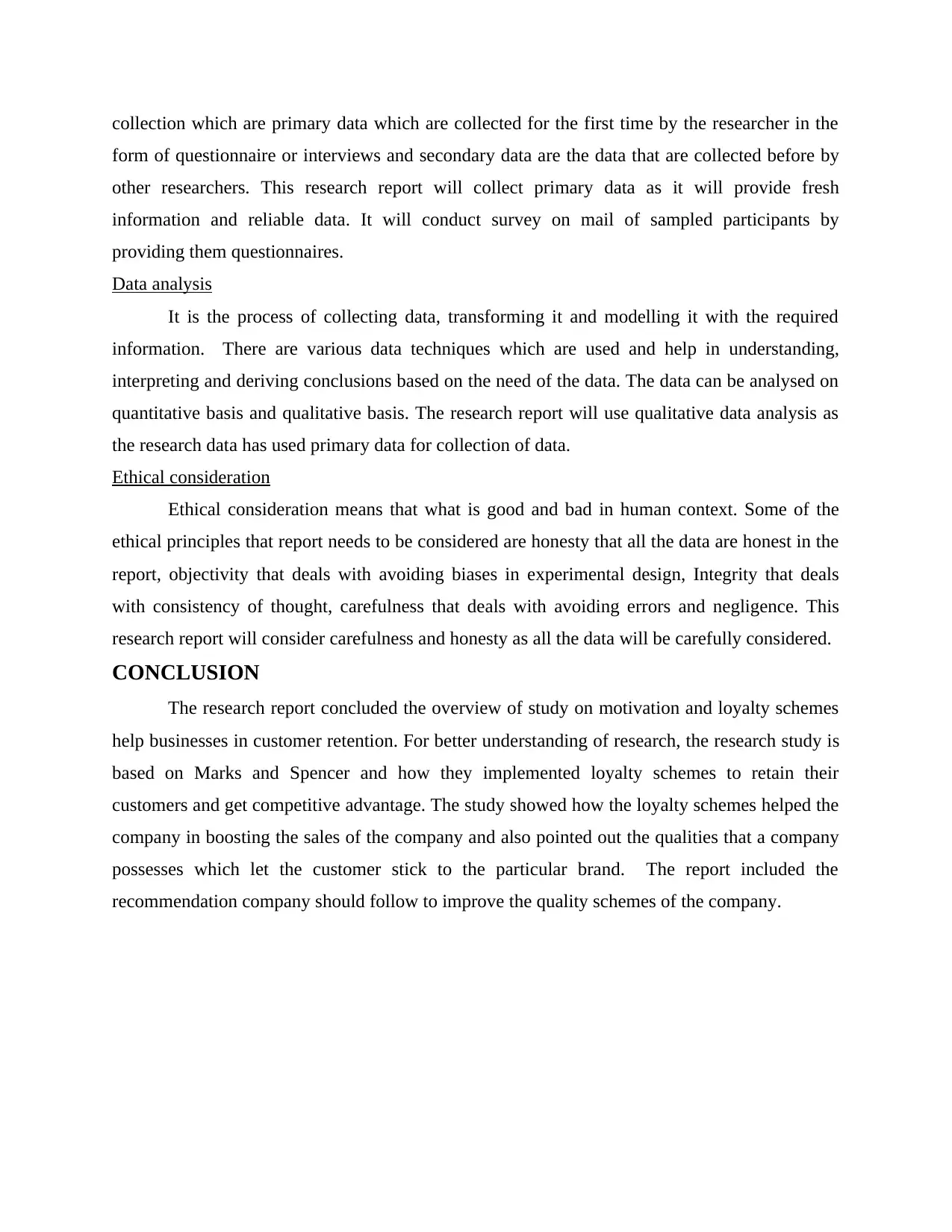
collection which are primary data which are collected for the first time by the researcher in the
form of questionnaire or interviews and secondary data are the data that are collected before by
other researchers. This research report will collect primary data as it will provide fresh
information and reliable data. It will conduct survey on mail of sampled participants by
providing them questionnaires.
Data analysis
It is the process of collecting data, transforming it and modelling it with the required
information. There are various data techniques which are used and help in understanding,
interpreting and deriving conclusions based on the need of the data. The data can be analysed on
quantitative basis and qualitative basis. The research report will use qualitative data analysis as
the research data has used primary data for collection of data.
Ethical consideration
Ethical consideration means that what is good and bad in human context. Some of the
ethical principles that report needs to be considered are honesty that all the data are honest in the
report, objectivity that deals with avoiding biases in experimental design, Integrity that deals
with consistency of thought, carefulness that deals with avoiding errors and negligence. This
research report will consider carefulness and honesty as all the data will be carefully considered.
CONCLUSION
The research report concluded the overview of study on motivation and loyalty schemes
help businesses in customer retention. For better understanding of research, the research study is
based on Marks and Spencer and how they implemented loyalty schemes to retain their
customers and get competitive advantage. The study showed how the loyalty schemes helped the
company in boosting the sales of the company and also pointed out the qualities that a company
possesses which let the customer stick to the particular brand. The report included the
recommendation company should follow to improve the quality schemes of the company.
form of questionnaire or interviews and secondary data are the data that are collected before by
other researchers. This research report will collect primary data as it will provide fresh
information and reliable data. It will conduct survey on mail of sampled participants by
providing them questionnaires.
Data analysis
It is the process of collecting data, transforming it and modelling it with the required
information. There are various data techniques which are used and help in understanding,
interpreting and deriving conclusions based on the need of the data. The data can be analysed on
quantitative basis and qualitative basis. The research report will use qualitative data analysis as
the research data has used primary data for collection of data.
Ethical consideration
Ethical consideration means that what is good and bad in human context. Some of the
ethical principles that report needs to be considered are honesty that all the data are honest in the
report, objectivity that deals with avoiding biases in experimental design, Integrity that deals
with consistency of thought, carefulness that deals with avoiding errors and negligence. This
research report will consider carefulness and honesty as all the data will be carefully considered.
CONCLUSION
The research report concluded the overview of study on motivation and loyalty schemes
help businesses in customer retention. For better understanding of research, the research study is
based on Marks and Spencer and how they implemented loyalty schemes to retain their
customers and get competitive advantage. The study showed how the loyalty schemes helped the
company in boosting the sales of the company and also pointed out the qualities that a company
possesses which let the customer stick to the particular brand. The report included the
recommendation company should follow to improve the quality schemes of the company.
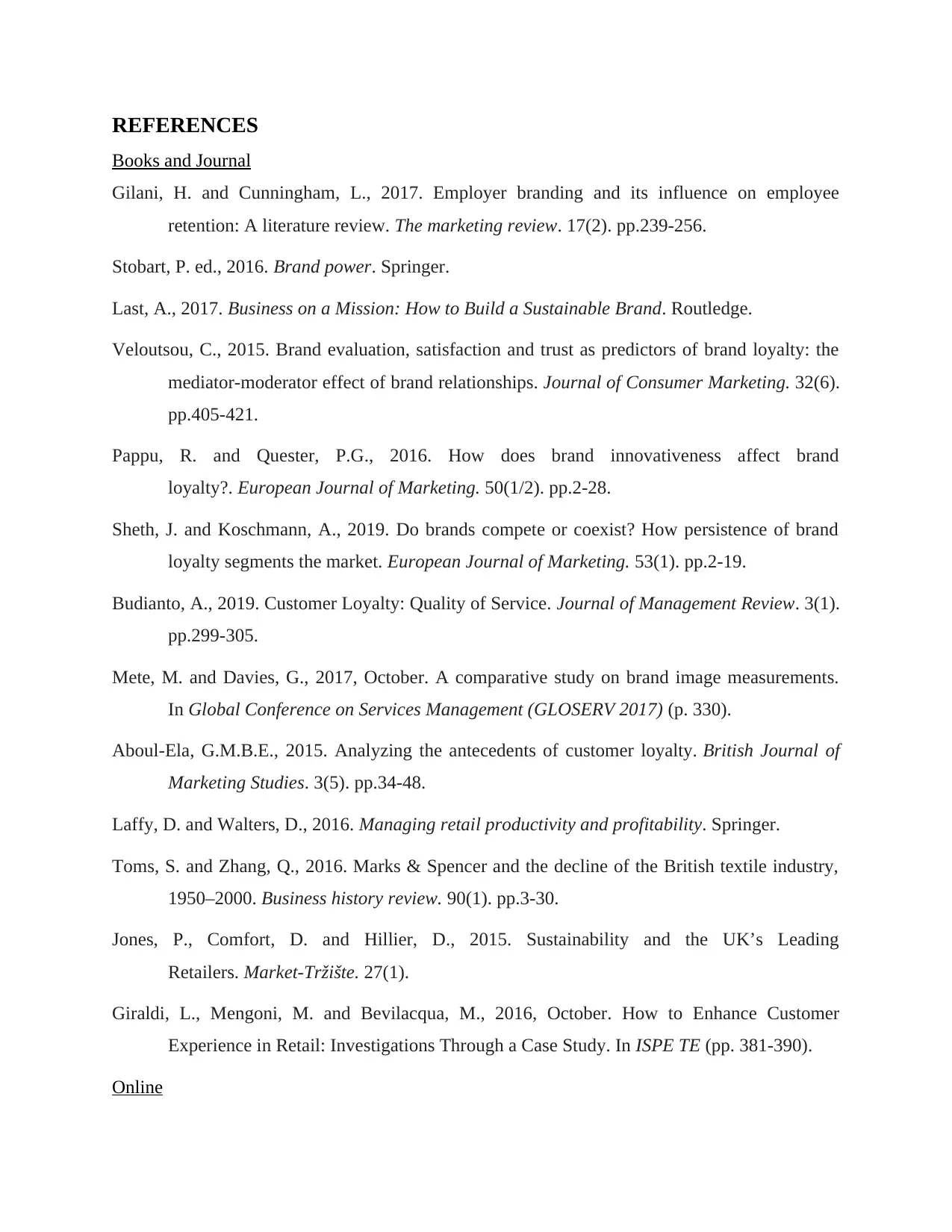
REFERENCES
Books and Journal
Gilani, H. and Cunningham, L., 2017. Employer branding and its influence on employee
retention: A literature review. The marketing review. 17(2). pp.239-256.
Stobart, P. ed., 2016. Brand power. Springer.
Last, A., 2017. Business on a Mission: How to Build a Sustainable Brand. Routledge.
Veloutsou, C., 2015. Brand evaluation, satisfaction and trust as predictors of brand loyalty: the
mediator-moderator effect of brand relationships. Journal of Consumer Marketing. 32(6).
pp.405-421.
Pappu, R. and Quester, P.G., 2016. How does brand innovativeness affect brand
loyalty?. European Journal of Marketing. 50(1/2). pp.2-28.
Sheth, J. and Koschmann, A., 2019. Do brands compete or coexist? How persistence of brand
loyalty segments the market. European Journal of Marketing. 53(1). pp.2-19.
Budianto, A., 2019. Customer Loyalty: Quality of Service. Journal of Management Review. 3(1).
pp.299-305.
Mete, M. and Davies, G., 2017, October. A comparative study on brand image measurements.
In Global Conference on Services Management (GLOSERV 2017) (p. 330).
Aboul-Ela, G.M.B.E., 2015. Analyzing the antecedents of customer loyalty. British Journal of
Marketing Studies. 3(5). pp.34-48.
Laffy, D. and Walters, D., 2016. Managing retail productivity and profitability. Springer.
Toms, S. and Zhang, Q., 2016. Marks & Spencer and the decline of the British textile industry,
1950–2000. Business history review. 90(1). pp.3-30.
Jones, P., Comfort, D. and Hillier, D., 2015. Sustainability and the UK’s Leading
Retailers. Market-Tržište. 27(1).
Giraldi, L., Mengoni, M. and Bevilacqua, M., 2016, October. How to Enhance Customer
Experience in Retail: Investigations Through a Case Study. In ISPE TE (pp. 381-390).
Online
Books and Journal
Gilani, H. and Cunningham, L., 2017. Employer branding and its influence on employee
retention: A literature review. The marketing review. 17(2). pp.239-256.
Stobart, P. ed., 2016. Brand power. Springer.
Last, A., 2017. Business on a Mission: How to Build a Sustainable Brand. Routledge.
Veloutsou, C., 2015. Brand evaluation, satisfaction and trust as predictors of brand loyalty: the
mediator-moderator effect of brand relationships. Journal of Consumer Marketing. 32(6).
pp.405-421.
Pappu, R. and Quester, P.G., 2016. How does brand innovativeness affect brand
loyalty?. European Journal of Marketing. 50(1/2). pp.2-28.
Sheth, J. and Koschmann, A., 2019. Do brands compete or coexist? How persistence of brand
loyalty segments the market. European Journal of Marketing. 53(1). pp.2-19.
Budianto, A., 2019. Customer Loyalty: Quality of Service. Journal of Management Review. 3(1).
pp.299-305.
Mete, M. and Davies, G., 2017, October. A comparative study on brand image measurements.
In Global Conference on Services Management (GLOSERV 2017) (p. 330).
Aboul-Ela, G.M.B.E., 2015. Analyzing the antecedents of customer loyalty. British Journal of
Marketing Studies. 3(5). pp.34-48.
Laffy, D. and Walters, D., 2016. Managing retail productivity and profitability. Springer.
Toms, S. and Zhang, Q., 2016. Marks & Spencer and the decline of the British textile industry,
1950–2000. Business history review. 90(1). pp.3-30.
Jones, P., Comfort, D. and Hillier, D., 2015. Sustainability and the UK’s Leading
Retailers. Market-Tržište. 27(1).
Giraldi, L., Mengoni, M. and Bevilacqua, M., 2016, October. How to Enhance Customer
Experience in Retail: Investigations Through a Case Study. In ISPE TE (pp. 381-390).
Online
⊘ This is a preview!⊘
Do you want full access?
Subscribe today to unlock all pages.

Trusted by 1+ million students worldwide
1 out of 13
Related Documents
Your All-in-One AI-Powered Toolkit for Academic Success.
+13062052269
info@desklib.com
Available 24*7 on WhatsApp / Email
![[object Object]](/_next/static/media/star-bottom.7253800d.svg)
Unlock your academic potential
Copyright © 2020–2025 A2Z Services. All Rights Reserved. Developed and managed by ZUCOL.





